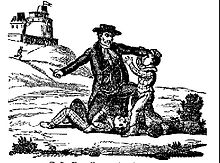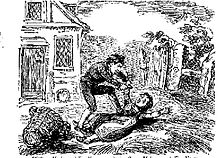- The Newgate Calendar
-
18th century illustration of William York, age 10, murdering Susan Matthew, age 5, on 13 May 1748, from The Newgate Calendar. York was sentenced to hang but was eventually pardoned

The Newgate Calendar, subtitled The Malefactors' Bloody Register, was a popular work of improving literature in the 18th and 19th centuries.
Originally a monthly bulletin of executions, produced by the keeper of Newgate Prison in London, the Calendar's title was appropriated by other publishers, who put out biographical chapbooks about notorious criminals such as Sawney Bean, Dick Turpin, John Wilkes and Moll Cutpurse.
Collected editions of these stories began to appear in the mid-18th century, and in 1774 a five-volume bound edition became the standard version. While many of its accounts are highly embellished and/or drawn uncritically from other sources, they are lively and full of incident, and often refer to contemporary events and social issues. Along with the Bible and John Bunyan's The Pilgrim's Progress, the Calendar was famously in the top three works most likely to be found in the average home.
The entries editorialise strongly against their subjects, Catholicism, The Protectorate and Commonwealth, any political enemies of Britain (such as the French), drunkenness, prostitution ("Women of abandoned character"), gambling, "dissipation" in general and other "vices" generally while eulogising Protestantism, the Church of England, the English monarchy and legal system, the Common Law and Bloody Code, with some rare exceptions. One edition contained an introduction suggesting that swindling be made (another) capital offence.
A new edition was published in 1824 by Andrew Knapp and William Baldwin, two lawyers, and a further edition in 1826, under the title, The New Newgate Calendar.
External links
Online editions
- Exclassics
- University of Texas, Law Library
- Versions from the Internet Archive
- Searchable database of the Calendar
Categories:- Penal system in the United Kingdom
- 1774 books
- Crime book stubs
Wikimedia Foundation. 2010.


